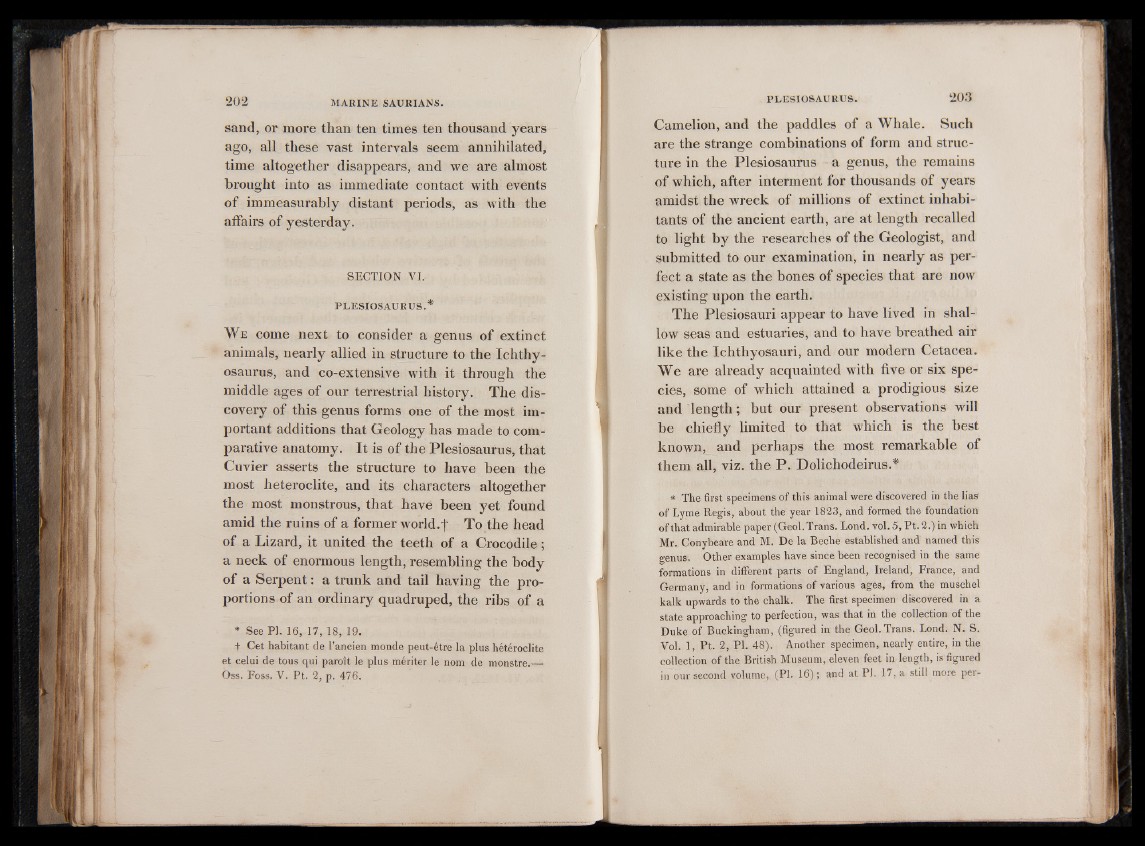
sand, or more than ten times ten thousand years
ago, all these vast intervals seem annihilated,
time altogether disappears, and we are almost
brought into as immediate contact with events
of immeasurably distant periods, as with the
affairs of yesterday.
SECTION VI.
PL E S IO SA U R U S .*
We come next to consider a genus of extinct
animals, nearly allied in structure to the Ichthyosaurus,
and co-extensive with it through the
middle ages of our terrestrial history. The discovery
of this genus forms one of the most important
additions that Geology has made to comparative
anatomy. It is of the Plesiosaurus, that
Cuvier asserts the structure to have been the
most heteroclite, and its characters altogether
the most monstrous, that have been yet found
amid the ruins of a former world.f To the head
of a Lizard, it united the teeth of a Crocodile ;
a neck of enormous length, resembling the body
of a Serpent : a trunk and tail having the proportions
of an ordinary quadruped, the ribs of a
* See PI. 16, 17, 18, 19.
t Cet habitant de l’ancien monde peut-être la plus hétéroclite
et celui de tous qui paroît le plus mériter le nom de monstre.—
Ôss. Foss, V. Pt. 2, p. 476.
Camelion, and the paddles of a Whale. Such
are the strange combinations of form and structure
in the Plesiosaurus a genus, the remains
of which, after interment for thousands of years
amidst the wreck of millions of extinct inhabitants
of the ancient earth, are at length recalled
to light by the researches of the Geologist, and
submitted to our examination, in nearly as perfect
a state as the bones of species that are now
existing upon the earth.
The Plesiosauri appear to have lived in shallow
seas and estuaries, and to have breathed air
like the Ichthyosauri, and our modern Cetacea.
We are already acquainted with five or six species,
some of which attained a prodigious size
and length; but our present observations will
be chiefly limited to that which is the best
known, and perhaps the most remarkable of
them all, viz. the P. Dolichodeirus.*
* The first specimens of this animal were discovered in the lias
of Lyme Regis, about the year 1823, and formed the foundation
of that admirable paper (Geol. Trans. Lond. vol. 5, Pt. 2.) in which
Mr. Conybeare and M. De la Beche established and named this
genus. Other examples have since been recognised in the same
formations in different parts of England, Ireland, France, and
Germany, and in formations of various ages, from the muschel
kalk upwards to the chalk. The first specimen discovered in a
state approaching to perfection, was that in the collection of the
Duke of Buckingham, (figured in the Geol. Trans. Lond. N. S.
Vol. 1, Pt. 2, PI. 48). Another specimen, nearly entire, in the
collection of the British Museum, eleven feet in length, is figured
in our second volume, (PL 16); and at PI. 17, a still more per